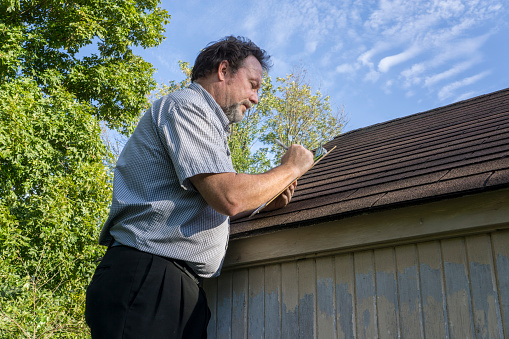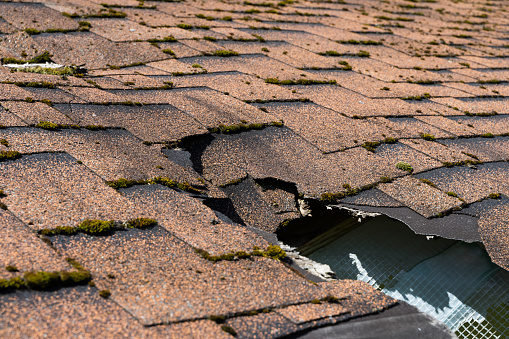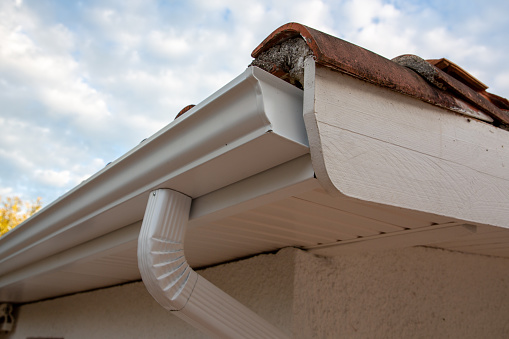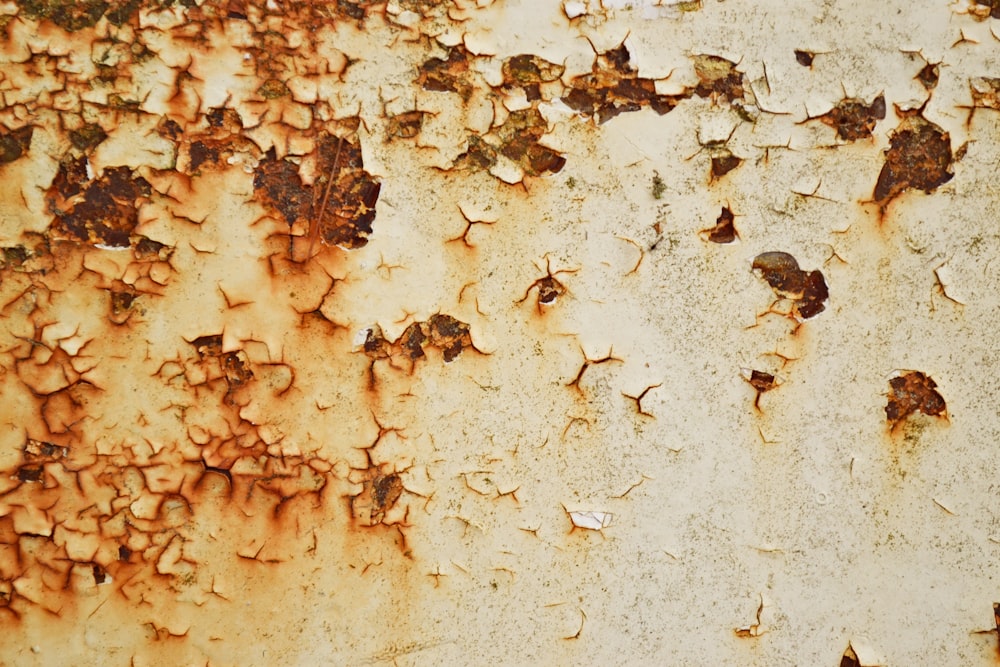
When it comes to protecting the structural integrity of your home, the roof is the unsung hero. It holds up under intense temperatures, strong wind speed, and relentless rainstorms, but even the sturdiest roofs can be vulnerable when hail hits.
Hail damage can leave a lasting impact on shingles and materials over time that may compromise their quality if not treated quickly and correctly. In this blog post, we will discuss some common signs of hail damage to look out for and how to deal with any potential damages caused by such inclement weather conditions.
What is Hail Damage?
Hail damage results from large chunks of ice, ranging from pea-sized to baseball-sized, pelting your roof during a hailstorm. The impact of these hail stones on your shingles and other materials on the roof can cause cosmetic or structural damage that can go unnoticed until it’s too late. The most common signs of hail damage include dents, broken pieces, and cracked or split shingles.
An Overview of Hail Damage to a Roof and its Potential Consequences

Hail damage can range from minor dents to major structural problems. The severity of the hail damage depends on the size of the hailstones the type and condition of your roof, and how exposed your home is to hailstorms. The following are some common types of hail damage that you should watch out for:
Cracks on the Shingles
The most obvious sign of hail damage is cracking on the shingles, which can range from minor to major. The longer it stays untreated, the worse the damage becomes. The hail stones can weaken the shingle’s protective layer, which can let in water, leading to further damage and costly repairs. The size of the cracks is also a good indicator of how serious the issue is – larger cracks usually indicate more significant damage.
For metal and composite roofing materials, hailstone impacts may cause dents, indentations, and visible damage to the surface. The most common places to find hailstone-related dents are in valleys and around chimneys or vents where the metal is exposed and unprotected. These dents may indicate that your roof system has sustained significant hail damage.
Fractured or Broken Shingles
Hailstones can also cause the roof shingles to fracture or break, often accompanied by a visible crack. The length and width of the cracked shingle will determine how severe the damage is and whether it’s wise to repair or replace your roof due to hail damage. Fortunately, in most cases, repairing broken shingles is relatively easy and affordable.
If you suspect your roof has sustained damage due to a hailstorm, it’s best to act quickly and get it inspected by a professional. The sooner you address the issue, the better, as hail damage can worsen.
A professional can help assess the extent of the damage and provide you with the best options for repairing or replacing your roof. The cost of repair or replacement will depend on the severity of the hail damage, but it’s best to address any potential issues as soon as possible to avoid further damage.
Granule Loss
Another common sign of hail damage is granule loss. The granules on asphalt shingles serve as a protective layer, shielding your roof from the elements. Granule loss due to hailstorms can leave your roof exposed and vulnerable to further damage from intense temperatures and sun exposure. The granules may need some time to replenish, so inspecting your roof as soon as possible is important.
If the hail damage is too severe and you need to replace your roof, hire a qualified contractor who can provide quality materials and artistry. The replacement cost will depend on the size of the area that needs replacing. Still, investing in a high-quality product that can withstand future hailstorms and other inclement weather conditions is important.
Damaged Gutters

Hailstones can also cause damage to your gutters, which is often overlooked. The hail’s impact may dent or warp the metal, causing it to leak. The presence of dented or warped gutters can indicate that you need to inspect and fix roof hail damage. The sooner you repair any damage, the less likely you’ll need to replace your gutters.
Advanced Staining and Discoloration
Advanced staining and discoloration are other signs of hail damage, particularly with wooden roofs. The impact of the hailstones can lead to splintering wood, which can leave a lasting impression on your roof’s beauty and performance. The longer it stays untreated, the worse the damage will be. The most effective way to address this issue is to replace any damaged wood and repair or replace the roof if necessary.
Debris on the Ground
If you notice debris on the ground after hail storms, your roof has likely sustained damage. The debris may be composed of shingle granules or pieces of broken shingles that have been dislodged due to hailstone impacts. The presence of this debris is an indicator that your roof needs to be inspected for hail damage. The sooner you act, the better, as it’s easier and more cost-effective to repair any minor damages before they become more serious over time.
Peeling Paint

Peeling paint on your home’s exterior is a common sign of hail damage. The impact of hailstones can cause the paint to flake and peel, leaving an unsightly impression that can be difficult to cover up.
The best way to address this issue is to get it repainted immediately. The cost of repainting will depend on the size of the area that needs to be touched up, so it’s best to get an estimate from a professional before proceeding.
Get a Roof Inspection for Hail Damage
If you’ve noticed any signs of hail damage listed above, it’s time to get a professional inspection. The earlier you can identify hail damage and address any issues, the better, as prompt action can help prevent further deterioration over time. The cost of repair or replacement will depend on the severity of the damage and whether or not the entire roof needs to be replaced.
The good news is that most homeowners’ insurance policies cover hail damage, so you may not have to pay out of pocket to repair or replace your roof.
When protecting your home from severe weather conditions, taking precautionary steps can save you time and money in the long run. The key is to stay alert and address any potential hail damage immediately. The more informed you are about common signs of hail damage, the better prepared you’ll be to deal with any issues.
The Cost of Replacing a Damaged Roof – Insurance Coverage Options

If your roof has sustained hail damage and needs to be replaced, it can be prohibitively expensive. The good news is that most homeowners’ insurance policies cover hail damage, so you may not have to pay out of pocket to repair or replace your roof.
The coverage will depend on your policy and the extent of the damage, so it’s important to read through the fine print before making any decisions. Replacing a roof can cost thousands of dollars, so having insurance claim coverage for hail damage is essential.
Tips for Repairing or Replacing a Hail-Damaged Roof
- Hire a professional roofing contractor who has experience dealing with hail damage. The quality of their work will be an important factor in ensuring your roof’s performance over time.
- Ask for references and read online reviews to ensure you’re hiring a reputable company.
- Get multiple estimates to compare pricing and ensure you get the best deal.
- Read your insurance policy carefully and contact your insurer with any questions or concerns.
How to Deal with Hail Damage
When dealing with hail damage, it’s important to be proactive. The sooner you can identify and address any issues, the better, as prompt action can help prevent further deterioration over time.
The key is to stay alert and monitor your roof for any signs of damage after a hail storm has passed. If necessary, get a professional hail damage roof inspection to confirm potential issues and take steps to repair or replace the damaged shingles. Replacing a roof can cost thousands of dollars, so having insurance coverage by the insurance company for hail damage is essential.
By watching for signs of hail damage, you can help ensure that your roof remains in good condition and protects your home for years. The hail impacts can be extensive, but with the right precautions, you can ensure that any issues are dealt swiftly and effectively.
FAQs
What are some common signs of hail damage?
The most common signs of hail damage include cracked or missing shingles, granule loss from the roof surface, dented gutters and downspouts, and indentations in metal surfaces such as air conditioning units.
How much does it cost to replace a hail-damaged roof?
The cost of replacing a roof can vary greatly depending on the size of the roof, the type of materials used, and the extent of the damage. The good news is that most homeowners’ insurance policies cover hail damage, so you may not have to pay out of pocket to repair or replace your roof.
What should I do if my roof has been damaged by hail?
The key is to stay alert and address any potential hail damage immediately. The more informed you are about common signs of hail roof damage, the better prepared you’ll be to deal with any issues. Hire a professional roofing contractor with experience dealing with hail damage. Read your insurance policy carefully and contact your insurer with any questions or concerns.
Conclusion
Hail damage can have a lasting impact on your roof’s structural integrity if left untreated. The key is to stay alert and address any potential hail damage immediately. Hiring a professional roofing contractor with experience dealing with hail damage and reading your insurance policy carefully are essential steps in ensuring that the right repairs or replacements are made.
Replacing a roof can be expensive, so having insurance coverage for hail damage is essential. By watching for signs of hail damage, you can help ensure that your roof remains in good condition and protects your home for years.